All About Atmospheric and Space Scientists
Occupation Description Investigate atmospheric phenomena and interpret meteorological data, gathered by surface and air stations, satellites, and radar to prepare reports and forecasts for public and other uses. Includes weather analysts and forecasters whose functions require the detailed knowledge of meteorology.
What Do Atmospheric and Space Scientists Do On a Daily Basis?
- Teach college-level courses on topics such as atmospheric and space science, meteorology, or global climate change.
- Analyze climate data sets, using techniques such as geophysical fluid dynamics, data assimilation, or numerical modeling.
- Create visualizations to illustrate historical or future changes in the Earth’s climate, using paleoclimate or climate geographic information systems (GIS) databases.
- Apply meteorological knowledge to issues such as global warming, pollution control, or ozone depletion.
- Perform managerial duties, such as creating work schedules, creating or implementing staff training, matching staff expertise to situations, or analyzing performance of offices.
- Prepare scientific atmospheric or climate reports, articles, or texts.
Featured schools near , edit
What Skills Do You Need to Work as an Atmospheric & Space Scientist?
Below is a list of the skills most Atmospheric and Space Scientists say are important on the job.
Reading Comprehension: Understanding written sentences and paragraphs in work related documents.
Active Listening: Giving full attention to what other people are saying, taking time to understand the points being made, asking questions as appropriate, and not interrupting at inappropriate times.
Writing: Communicating effectively in writing as appropriate for the needs of the audience.
Speaking: Talking to others to convey information effectively.
Science: Using scientific rules and methods to solve problems.
Critical Thinking: Using logic and reasoning to identify the strengths and weaknesses of alternative solutions, conclusions or approaches to problems.
Related Job Titles for this Occupation:
- Synoptic Meteorologist
- Weather Reporter
- Climate Change Risk Assessor
- Science and Operations Officer (SOO)
- Tracker
Atmospheric & Space Scientist Employment Estimates
In 2016, there was an estimated number of 10,400 jobs in the United States for Atmospheric and Space Scientist. New jobs are being produced at a rate of 12.5% which is above the national average. The Bureau of Labor Statistics predicts 1,300 new jobs for Atmospheric and Space Scientist by 2026. Due to new job openings and attrition, there will be an average of 900 job openings in this field each year.
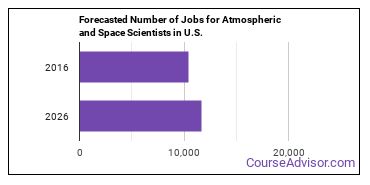
The states with the most job growth for Atmospheric & Space Scientist are Colorado, Utah, and New Hampshire. Watch out if you plan on working in Rhode Island, Missouri, or Kansas. These states have the worst job growth for this type of profession.
What is the Average Salary of an Atmospheric & Space Scientist
Atmospheric and Space Scientists make between $50,040 and $142,500 a year.
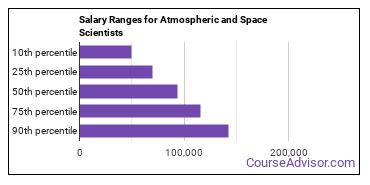
Atmospheric and Space Scientists who work in District of Columbia, Maryland, or New Mexico, make the highest salaries.
Below is a list of the median annual salaries for Atmospheric and Space Scientists in different U.S. states.
| State | Annual Mean Salary |
|---|---|
| Alabama | $104,130 |
| Alaska | $85,980 |
| Arizona | $93,870 |
| California | $102,020 |
| Colorado | $96,890 |
| Connecticut | $58,980 |
| District of Columbia | $138,020 |
| Florida | $95,110 |
| Georgia | $99,890 |
| Hawaii | $103,960 |
| Idaho | $97,900 |
| Illinois | $71,400 |
| Indiana | $97,520 |
| Iowa | $89,230 |
| Kansas | $85,740 |
| Kentucky | $106,450 |
| Louisiana | $84,150 |
| Maryland | $110,150 |
| Michigan | $89,840 |
| Minnesota | $102,520 |
| Mississippi | $73,270 |
| Missouri | $95,500 |
| Montana | $85,770 |
| Nebraska | $89,990 |
| Nevada | $93,770 |
| New Hampshire | $80,880 |
| New Jersey | $95,560 |
| New Mexico | $111,090 |
| New York | $89,840 |
| North Carolina | $77,830 |
| North Dakota | $74,050 |
| Ohio | $91,370 |
| Oklahoma | $81,970 |
| Oregon | $90,390 |
| Pennsylvania | $104,380 |
| South Carolina | $96,170 |
| South Dakota | $82,600 |
| Tennessee | $95,740 |
| Texas | $93,810 |
| Utah | $87,130 |
| Virginia | $108,330 |
| Washington | $92,700 |
| Wisconsin | $93,100 |
| Wyoming | $87,910 |
What Tools do Atmospheric and Space Scientists Use?
Although they’re not necessarily needed for all jobs, the following technologies are used by many Atmospheric and Space Scientists:
- Microsoft Excel
- Microsoft Word
- Microsoft Office
- Microsoft PowerPoint
- Microsoft Outlook
- Python
- Microsoft Access
- Word processing software
- Microsoft Windows
- Adobe Systems Adobe Photoshop
- Structured query language SQL
- The MathWorks MATLAB
- SAS
- Linux
- IBM SPSS Statistics
- UNIX
- R
- Practical extraction and reporting language Perl
- Apple Final Cut Pro
Becoming an Atmospheric & Space Scientist
Learn what Atmospheric and Space Scientist education requirements there are.
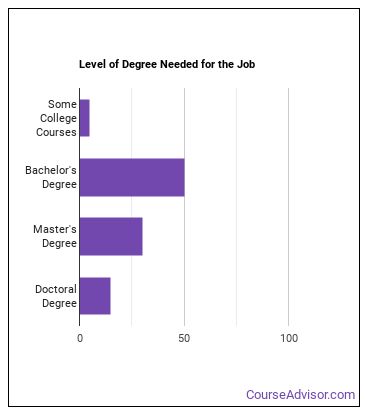
What work experience do I need to become an Atmospheric & Space Scientist?
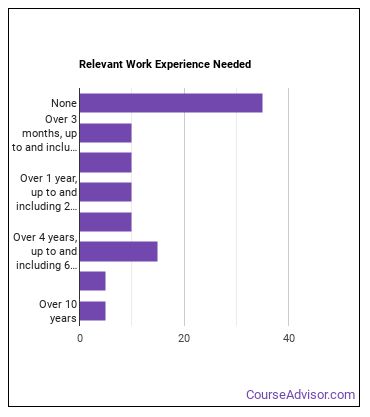
Who Employs Atmospheric and Space Scientists?
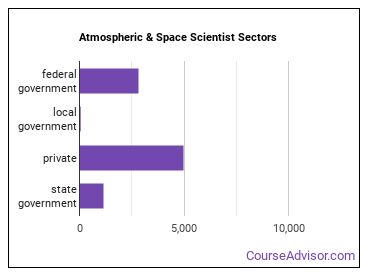
The table below shows the approximate number of Atmospheric and Space Scientists employed by various industries.
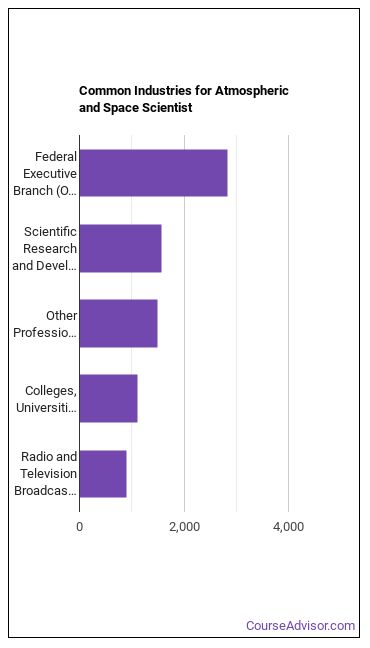
Other Jobs You May be Interested In
Those thinking about becoming an Atmospheric and Space Scientist might also be interested in the following careers:
Those who work as an Atmospheric and Space Scientist sometimes switch careers to one of these choices:
References:
Image Credit: Liam Gumley via NASA, public domain
More about our data sources and methodologies.
Featured Schools
 Request Info
Request Info
|
Southern New Hampshire University You have goals. Southern New Hampshire University can help you get there. Whether you need a bachelor's degree to get into a career or want a master's degree to move up in your current career, SNHU has an online program for you. Find your degree from over 200 online programs. Learn More > |
